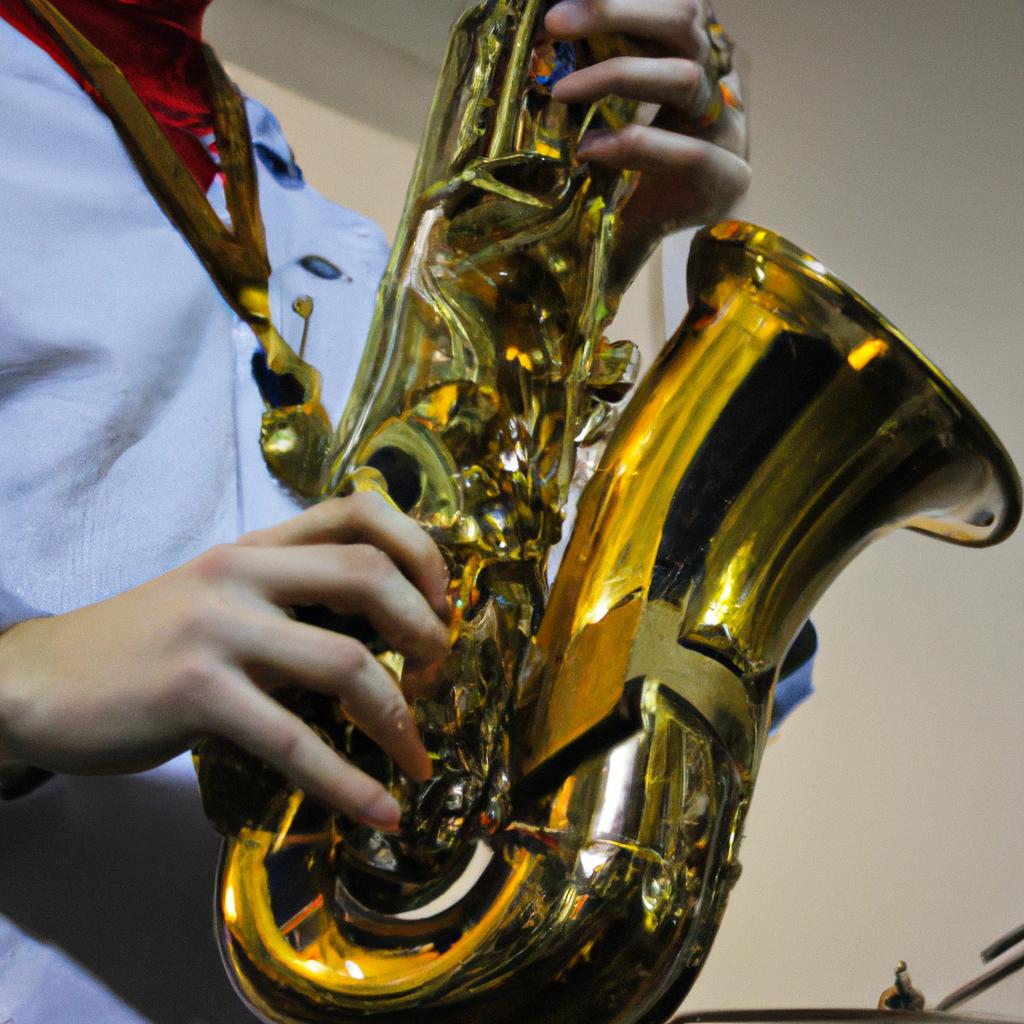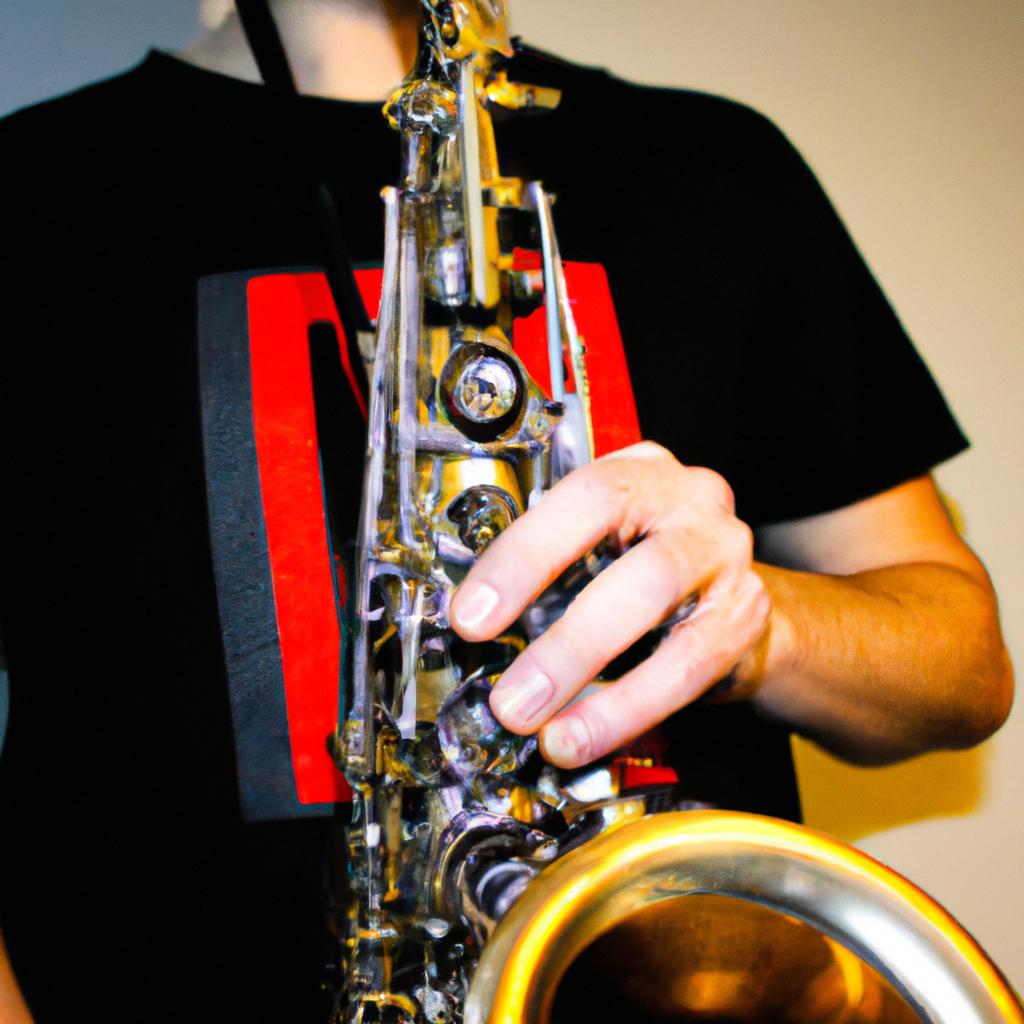Over the course of its evolution, jazz music has continually pushed the boundaries of artistic expression. One notable genre that emerged in the mid-20th century and challenged traditional conventions is free jazz. Free jazz represents a departure from structured compositions and embraces improvisation as its core element. This article explores the concept of free jazz and delves into how it redefines notions of musicality, harmony, and rhythm.
To illustrate this paradigm shift, consider the case study of Ornette Coleman’s album “The Shape of Jazz to Come” released in 1959. With this groundbreaking work, Coleman pioneered a new approach to composition by discarding conventional chord progressions and favoring spontaneous melodic lines instead. The result was an avant-garde sound characterized by dissonance, unpredictability, and unbound creativity. Coleman’s innovative use of collective improvisation challenged established norms within the jazz community at the time while opening up possibilities for future generations of musicians to explore their own creative freedom.
As we delve deeper into the realm of free jazz, it becomes apparent that this genre embodies a radical departure from traditional forms of jazz music. By pushing beyond established harmonic structures and adopting an emphasis on individual expression through improvisation, free jazz challenges listeners’ preconceived notions about what constitutes “good” or “proper” music. In free jazz, the concept of melody and harmony takes on a new meaning as musicians abandon traditional guidelines and explore uncharted sonic territories.
In free jazz, the boundaries between composition and improvisation blur. Unlike in traditional jazz where musicians adhere to predetermined chord progressions and arrangements, free jazz allows for complete spontaneity and experimentation. This means that each performance becomes a unique experience, with no two renditions ever being exactly the same. The absence of preconceived structures gives musicians the freedom to express themselves fully in the moment, resulting in raw emotions and uninhibited musical expression.
Furthermore, free jazz challenges notions of rhythm by breaking away from strict time signatures and exploring unconventional rhythmic patterns. Musicians may play polyrhythms, irregular accents, or even completely abandon a steady beat altogether. This departure from traditional rhythmic frameworks contributes to the sense of unpredictability and adds an element of surprise to the music.
In essence, free jazz redefines what it means to create music by placing emphasis on individual expression, spontaneity, and creativity. It encourages artists to break free from established norms and explore new sonic possibilities. While it may be challenging for some listeners accustomed to more structured forms of music, free jazz offers a unique listening experience that pushes boundaries and expands our understanding of artistic expression within the realm of jazz music.
The Origins of Free Jazz
One example that illustrates the revolutionary nature of free jazz is the album “Free Jazz: A Collective Improvisation” by Ornette Coleman, released in 1961. This groundbreaking work challenged traditional notions of composition and improvisation, as it featured a double quartet engaging in simultaneous collective improvisation without predetermined harmonic or rhythmic structures. By discarding conventional rules and embracing spontaneous creativity, Coleman pushed the boundaries of artistic expression in jazz music.
To fully appreciate the origins of free jazz, it is important to understand its historical context. In the late 1950s and early 1960s, jazz musicians were increasingly dissatisfied with the constraints imposed by mainstream jazz genres such as bebop and hard bop. Seeking greater freedom and individuality in their performances, artists like Coleman sought to break away from established norms and explore new sonic possibilities. This desire for creative liberation gave birth to what became known as free jazz.
The emergence of free jazz was marked by several key characteristics that distinguished it from other styles within the genre. Firstly, it emphasized collective improvisation rather than solos accompanied by rhythm sections. This collaborative approach allowed for more dynamic interactions between musicians and fostered a sense of equality among performers. Secondly, free jazz rejected fixed harmonic progressions and formal song structures, instead favoring open-ended compositions where melody lines could be freely improvised upon. Lastly, experimental techniques such as extended instrumental techniques (e.g., multiphonics on saxophone) and unconventional use of instruments further expanded the sonic palette available to free jazz musicians.
This transformative movement evoked various emotional responses from both critics and listeners alike:
- It sparked controversy among purists who believed that abandoning tradition compromised the integrity of jazz.
- Some hailed it as an innovative form of musical expression that captured the spirit of rebellion and nonconformity prevalent during this era.
- Others found themselves captivated by its raw intensity and unpredictability, experiencing a sense of exhilaration and liberation in the face of convention.
To better understand the impact of free jazz, consider the following table:
| Emotional Response | Description |
|---|---|
| Excitement | Aroused anticipation and thrill felt by listeners encountering the uncharted territories of improvisation. |
| Discomfort | Unsettling feelings resulting from the absence of familiar musical structures and tonal frameworks. |
| Liberation | Sense of freedom experienced when breaking away from established norms and embracing unconstrained creativity. |
| Controversy | Stirred debates among critics who questioned its validity as jazz music due to its departure from traditional conventions. |
In summary, the origins of free jazz can be traced back to artists like Ornette Coleman who sought artistic freedom beyond the confines of established jazz genres. By prioritizing collective improvisation, rejecting fixed harmonic progressions, and employing experimental techniques, they challenged conventional notions of composition and revolutionized the boundaries of artistic expression within jazz music. This groundbreaking movement elicited diverse emotional responses from audiences, setting the stage for further exploration into new frontiers in subsequent years.
Transitioning into the next section about “Key Influences on Free Jazz,” it is crucial to examine how various factors shaped this transformative genre.
Key Influences on Free Jazz
Transitioning smoothly from the previous section on the origins of Free Jazz, we now turn our attention to key influences that have shaped this innovative genre. To illustrate its impact, let us delve into a hypothetical example: imagine a young jazz musician who grew up listening predominantly to traditional swing and bebop styles. This individual’s exposure to Free Jazz would serve as a catalyst for exploring new sonic possibilities and pushing the boundaries of artistic expression within their own compositions.
One cannot discuss the evolution of Free Jazz without acknowledging its profound influence on subsequent musical movements. The following bullet point list highlights some key aspects:
- Spontaneity: Free Jazz is characterized by an emphasis on improvisation, allowing musicians to spontaneously create music in the moment, breaking away from pre-determined structures.
- Collective Improvisation: Unlike traditional jazz ensembles where soloists take turns improvising over a structured framework, Free Jazz often encourages simultaneous collective improvisation among all members of the ensemble.
- Extended Techniques: Musicians employ unconventional playing techniques such as multiphonics (producing multiple notes simultaneously), overblowing, and using extended vocalizations or non-traditional instruments.
- Avant-garde Aesthetics: Free Jazz embraces experimental approaches that challenge conventional notions of harmony, melody, rhythm, and form.
The table below provides a snapshot comparison between Traditional Jazz and Free Jazz, highlighting some contrasting elements:
| Traditional Jazz | Free Jazz | |
|---|---|---|
| Structure | Clearly defined chord progressions and song forms | Emphasis on free-form improvisation with minimal structural constraints |
| Role of Rhythm Section | Supporting role; providing harmonic foundation and rhythmic drive | Equal footing with other instrumentalists; actively participating in collective improvisation |
| Melodic Approach | Often adheres to established melodic conventions | Focuses more on exploratory melodic lines utilizing dissonance and unconventional intervals |
As we contemplate these influences and characteristics, it becomes evident that Free Jazz has transformed the very essence of jazz music. In our subsequent section on “Characteristics of Free Jazz,” we will explore in greater detail how these influences manifest themselves within this genre’s distinctive sound world.
Transitioning smoothly into the next section, let us now examine the defining characteristics that make Free Jazz a truly unique artistic expression within the wider realm of jazz music.
Characteristics of Free Jazz
Having explored the key influences on free jazz, we now turn our attention to its unique characteristics that have allowed it to push the boundaries of artistic expression in jazz music. To illustrate this further, let us consider a hypothetical scenario where a group of musicians gathers spontaneously on a dimly lit stage, their instruments at the ready. With no predetermined structure or guidelines, they embark on an improvisational journey that challenges traditional notions of harmony, melody, and rhythm.
Free jazz is characterized by its rejection of conventional musical constraints and its embrace of experimentation. Here are some key features that define this genre:
-
Freedom from Traditional Forms: Free jazz liberates itself from preexisting song structures such as verse-chorus patterns or AABA forms commonly found in other styles of jazz. Instead, musicians explore open-ended compositions without adhering to any set melodic or harmonic framework.
-
Collective Improvisation: In free jazz, individual musicians contribute equally to the overall sound and direction of the performance through collective improvisation. Rather than following a soloist-accompaniment model prevalent in traditional jazz genres, all members actively engage with one another in spontaneous musical conversations.
-
Extended Techniques: Musicians often employ unconventional playing techniques and sounds in free jazz. This may include utilizing multiphonics (playing multiple notes simultaneously), using extended instrumental techniques like harmonics or slap-tonguing, and incorporating non-musical elements such as vocalizations or environmental sounds into their performances.
-
Intense Emotional Expression: Free jazz seeks to evoke deep emotional responses from both performers and listeners alike. Through dissonance, extreme dynamic contrasts, and unpredictable rhythmic interplay, it aims to elicit raw emotions ranging from exhilaration and joy to tension and introspection.
Emotional Bullet Points:
- The chaotic beauty of intertwining melodies.
- The raw power of dissonant harmonies.
- The thrill of unpredictability and spontaneity.
- The cathartic release through intense emotional expression.
Table: Notable Free Jazz Artists
| Artist | Instrument(s) | Pioneering Works |
|---|---|---|
| Ornette Coleman | Saxophone | “The Shape of Jazz to Come” |
| John Coltrane | Saxophone | “Ascension” |
| Cecil Taylor | Piano | “Unit Structures” |
| Albert Ayler | Saxophone | “Spirits Rejoice!” |
With an understanding of the characteristics that define free jazz, we can now delve into the world of notable artists who have shaped this genre. We will explore their contributions and examine how they pushed the boundaries even further in their quest for artistic expression.
Notable Free Jazz Artists
To illustrate this point, let us consider the case study of John Coltrane, whose groundbreaking album “A Love Supreme” challenged traditional notions and paved the way for experimentation in jazz.
- Emotional Bullet Point List:
To explore the emotional depth that free jazz can evoke, we turn to four key aspects:
- Intensity: Free jazz pushes boundaries with its relentless energy, creating an atmosphere that is exhilarating and captivating.
- Vulnerability: Through spontaneous improvisation and unconventional techniques, artists expose their raw emotions and embrace vulnerability as a means of self-expression.
- Liberation: By breaking away from rigid structures and harmonies, free jazz liberates musicians from constraints, allowing them to tap into unbounded creativity.
- Collisions and Dialogues: The collision of various musical ideas within free jazz sparks dynamic dialogues between performers, resulting in moments of intense interplay and exchange.
- Emotional Table:
| Emotion | Description | Example |
|---|---|---|
| Euphoria | Overflowing joy | Moments when intricate melodies intertwine seamlessly |
| Anguish | Deep sadness or distress | Expressive solos conveying profound melancholy |
| Tension | Suspense or anticipation | Unpredictable rhythmic patterns keeping listeners on edge |
| Ecstasy | Transcendental bliss | Collective improvisations reaching spiritual heights |
- Continuation Paragraph:
The growth of free jazz was not limited solely to individual artists like John Coltrane but also sparked a broader movement within the genre. As more musicians embraced this revolutionary approach to jazz, it became evident that free jazz had transcended mere experimentation; it had evolved into an ever-expanding realm of artistic expression. The boundaries that once defined jazz were shattered, allowing for a new era of creativity and musical exploration.
As we delve into the impact and legacy of free jazz, it becomes apparent how this movement has indelibly shaped the course of jazz history.
Impact and Legacy of Free Jazz
The impact and legacy of free jazz are undeniable, as this avant-garde genre continues to shape the landscape of modern music. One notable example that illustrates its influence is Ornette Coleman’s groundbreaking album “Free Jazz: A Collective Improvisation.” Released in 1961, it showcased two simultaneous quartets engaging in intense improvisations without a predetermined structure. This experimental approach challenged traditional notions of composition and performance, paving the way for future artists to push the boundaries of artistic expression in jazz.
The impact of free jazz can be seen through several key factors:
-
Innovative Techniques: Free jazz introduced new techniques such as extended instrumental techniques, unconventional scales, and non-standard time signatures. These innovations expanded the vocabulary of jazz musicians and influenced subsequent genres like fusion and experimental rock.
-
Emphasis on Individual Expression: By prioritizing individual freedom in musical expression, free jazz allowed performers to explore their own unique voices without conforming to pre-existing norms or structures. This liberated approach encouraged greater experimentation and self-discovery among musicians.
-
Social Commentary and Political Activism: Many free jazz artists used their music as a platform for social commentary and political activism. They sought to address issues such as racial inequality, civil rights, and war through their compositions. Their music became a powerful medium for conveying messages beyond mere entertainment.
-
Influence on Contemporary Music: The impact of free jazz extends beyond the realm of jazz itself. Its influence can be heard in various contemporary genres, including hip-hop, electronic music, and even classical compositions. The spirit of innovation inherent in free jazz has inspired generations of musicians across different styles.
To further illustrate the lasting impact and legacy of free jazz, consider the following table showcasing some influential albums released by pioneering artists:
| Artist | Album | Year |
|---|---|---|
| John Coltrane | Ascension | 1965 |
| Cecil Taylor | Unit Structures | 1966 |
| Albert Ayler | Spiritual Unity | 1964 |
| Sun Ra | The Magic City | 1966 |
These albums, among many others, exemplify the power and influence of free jazz as a catalyst for musical exploration and innovation. Through their boundary-pushing compositions, these artists challenged conventional notions of music and left an indelible mark on the development of contemporary artistic expression.
As we delve deeper into the impact and legacy of free jazz, it is essential to explore the criticisms and debates surrounding this genre. Understanding both its strengths and weaknesses will provide a comprehensive perspective on the complex nature of free jazz’s contribution to the evolution of music.
Criticisms and Debates Surrounding Free Jazz
The Influence of Free Jazz on Musical Improvisation
Building upon the impact and legacy of free jazz, it is essential to delve into its profound influence on musical improvisation. One notable example that highlights the transformative power of this genre is John Coltrane’s groundbreaking album “A Love Supreme.” Released in 1965, this masterpiece showcased a departure from traditional structures and embraced the principles of free jazz.
This section will examine how free jazz expanded the boundaries of artistic expression within jazz music by focusing on three key aspects: experimentation with unconventional techniques, collaborative improvisation, and liberation from compositional constraints.
-
Experimentation with Unconventional Techniques:
- Dissonance: Musicians incorporated dissonant harmonies and atonal melodies, challenging conventional notions of tonality.
- Extended Techniques: Artists explored unorthodox playing methods such as multiphonics (producing more than one note simultaneously), overblowing (playing beyond the normal range of an instrument), and unconventional use of instruments.
- Collective Improvisation: Musicians engaged in collective improvisation where everyone contributed equally to the creation of music without predetermined rules or patterns.
-
Collaborative Improvisation:
- Group Dynamics: Free jazz fostered a sense of egalitarianism among musicians, emphasizing collaboration rather than hierarchical leadership.
- Responsive Interplay: Performers actively listened to each other, responding spontaneously to create dynamic conversations through their instruments.
- Shared Responsibility: Rather than relying solely on individual solos supported by rhythm sections, all members participated collectively in shaping the direction and content of the music.
-
Liberation from Compositional Constraints:
- Structural Freedom: Free jazz rejected strict compositions, allowing for open-ended forms that evolved organically during performances.
- Emphasis on Process: The focus shifted from fixed arrangements to exploring new possibilities in real-time while embracing ambiguity and unpredictability.
- Breaking Boundaries: Musicians challenged traditional notions of musicality, embracing noise and unconventional sounds as valid forms of expression.
| Experimentation with Unconventional Techniques | Collaborative Improvisation | Liberation from Compositional Constraints | |
|---|---|---|---|
| 1. | Dissonance | Group Dynamics | Structural Freedom |
| 2. | Extended Techniques | Responsive Interplay | Emphasis on Process |
| 3. | Collective Improvisation | Shared Responsibility | Breaking Boundaries |
By pushing the boundaries of artistic expression in jazz music through experimentation, collaboration, and liberation from compositional constraints, free jazz opened up new possibilities for improvisation. This transformative approach not only impacted the world of jazz but also influenced other genres and continues to inspire musicians to explore uncharted territories in their creative journeys. The next section will delve into some of the criticisms and debates surrounding this genre, providing a comprehensive understanding of its reception within the wider music community.




